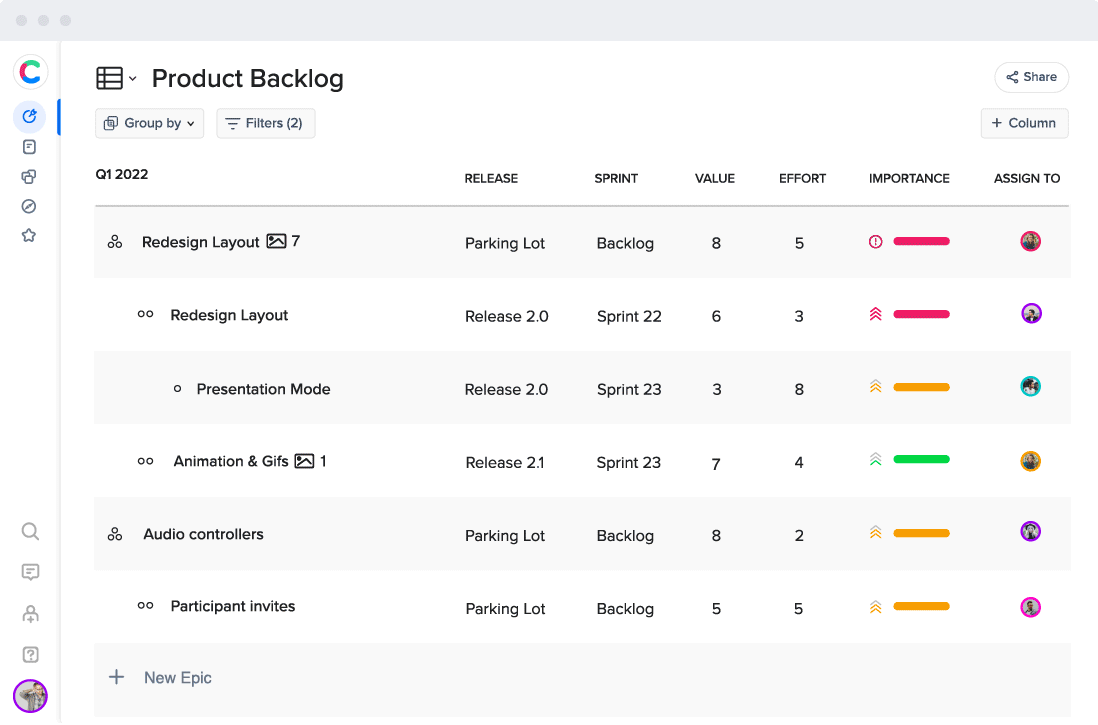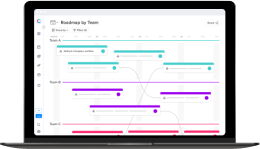Home > Blog > Let’s Talk About Product Goals
Let’s Talk About Product Goals

Why Measurable Product Goals Are Must-Haves for Every Product Team
How will you know if your initiative is a success?
Product-team brainstorming sessions can be some of the most exciting and optimistic moments a business ever experiences. When they land on an idea that they believe has strong potential,
team members often bounce around the room cheering that the new product is going to take the industry by storm or revolutionize the way its user works or lives.
Those are great hopes to have. But again: How will you know if the initiative is a success? There’s no digital counter that will sound off to let you know – DING! – you’ve revolutionized your users’ workflows or taken your industry by storm.
If you haven’t set product success goals ahead of time, how will you know whether to keep moving in the original direction of your roadmap, adjust your priorities, or try something new completely? This is why your team needs product goals – measurable goals.
If you spend any time in product leadership, you’ll be astonished watching how much energy product professionals spend thinking up cool features and marketing messages, and how little time they’ll devote to establishing the metrics that will help them determine if the product is a market success.
So, let’s discuss why learning how to set quantifiable product goals is so important – indeed, necessary – to your product’s success (not to mention the success and longevity of your product management career). Then we’ll share a few common examples of when it’s especially important to set and monitor product goals.
Product Goals Are an Invaluable Form of Feedback
First things first: What is a product goal? The textbook definition would describe it as a KPI-driven metric that connects the product vision and execution. But an easier way to grasp the concept might be to think of a product goal as a credible source of market feedback.
Skilled Product Managers understand the value of collecting and analyzing user feedback. That information represents a direct, ongoing line of communication to the people interacting with a company’s product and sharing what they like and don’t like about it. Product teams often use this data to adjust their product priorities and guide their roadmapping.
In fact, organizations often take product requests, comments, and complaints so seriously that we at craft.io have warned that Product Managers shouldn’t over-rely on customer feedback.
But to the extent that market feedback is a useful form of data, product goals can be extremely beneficial – even more useful than customer feedback. One reason we caution against placing too much weight on user complaints, for example, is that those complaints might represent only a small but loud segment of your user base. It might not reflect the feelings of the majority of your existing customers.
With quantifiable product goals, you are also receiving real-world feedback about how your target users are responding to your product. But unlike the request/suggestion/complaint form of feedback, product goals give you objective numbers that tell you directly whether your product is succeeding.
If you receive 11 user complaints that your software’s user interface is too complicated, that’s useful data. But it alone can’t tell you whether or not your product is resonating with users.
If instead you set a product goal of signing up 150 paying customers in the next 12 months – and book 212 customers in that time – you know your product is succeeding. You don’t need further interpretation, as you would with those 11 complaints, to determine whether or not the feedback represents something more significant about how the product is resonating with users.
Product goals should always include milestones.
In product roadmapping, you always begin your planning from the highest strategic level and then break down those large strategic ideas into more actionable items.
Using the agile product development method, for example, you’ll first come up with a couple of big-picture product themes to focus on, and then identify several epics to support each theme. The same principle is at work for developing product goals. Let’s use a simple example to set the stage.
First, you’ll identify the high-level goal:
Lose 20 pounds in 3 months.
Then you’ll establish several milestones to aim for and monitor your progress:
- Reduce sugar consumption to 1 item per day
- Jog 3 times per week
- Fast intermittently (16 hours) at least 2 times per week
- Check weight after 10 days (should have lost at least 4 pounds)
- Check weight each week thereafter (should be losing 2 pounds per week)
Milestones help you guide your day-to-day actions and give you measurable feedback along the way to determine if you are making progress toward the product goal.
Examples from the world of Product Management
While personal health speaks to everyone, I put together a short list of product-related examples that may be more enlightening to the product professionals among us:
- Product goal – increase user retention by 15% in Q1
- Milestones
- Re-do entire onboarding drip campaign (6 emails)
- Implement analytics tool by end of month
- Implement support-bot by end of month
- Add 15 items to knowledge base, based on user searches
- Design and launch incentive plan, including up to 25% discount
- Product goal: double average weekly sessions on mobile by end of May
- Milestones
- QA all mobile functions
- Improve loading time by 30%
- Add 3 top integrations to mobile version
When to Develop Product Goals: Examples
As we noted above, you can think of product goals as KPI-driven elements that serve as the bridge between product vision and execution.
This is one reason that as a Product Manager, you should always be thinking through and re-examining your product goals (for both your new products and those already on the market). You should also remain open to new product goals — because successful products evolve over time, and markets are fickle.
And although any team might create its own unique product goal definition, it’s a good idea to make sure that the goals you set always answer at least the following questions:
- What are we hoping to accomplish?
- What’s our timeframe for meeting this objective?
- What will success look like?
(Note: If you don’t have a quantifiable metric attached to your product goal, you won’t be able to determine if and when you’ve achieved it.)
With those criteria in mind, here are a few common types of goals that Product Managers and Product Owners might set for their products. You can use these for brainstorming your own product goals:
| Product goal | Timeframe | Success metric |
| Boost usage with free trial | 9 months | Reach 1,500 trial users |
| Increase trial conversions | 6 months | Boost post-trial paid signups from 4% to 8% |
| Increase revenue | 12 months | Grow MRR from $400,000 to $600,000 |
There are also moments or events in a product’s lifecycle when Product Managers will want to add new goals — and possibly adjust their existing ones as well. Here are a couple of event-specific examples of product goal triggers:
You’ll need product goals when launching a new product.
Here, a Product Manager or Product Owner might develop preliminary iteration goals for the product’s release — such as 350 free-trial signups within the first three months.
We describe these as “preliminary iteration goals” because, until the product hits the market, your team might not have enough data to pinpoint the right range of new users to expect (or whatever other product goal example you’re using as a metric).
You’ll need product goals when entering a new market segment.
When your team wants to introduce your product to a new user persona or new industry, you’ll want to create some specific product goals for this event.
Perhaps you’ll set a goal of gaining a 3% market share for your product in the new industry within the first year.
Pro Tip: Connect Every Item on Your Roadmap to a Product Goal
If you want to make product goals a routine part of your product planning, one best practice is to use a product management platform that lets you easily connect every new item on your roadmap to a specific Objective and Key Result (OKR).
One example is the award-winning craft.io product management platform – used by world-class product teams at companies like Kimberly-Clark, Cisco, SAP, and Marks & Spencer.

Try craft.io for free





